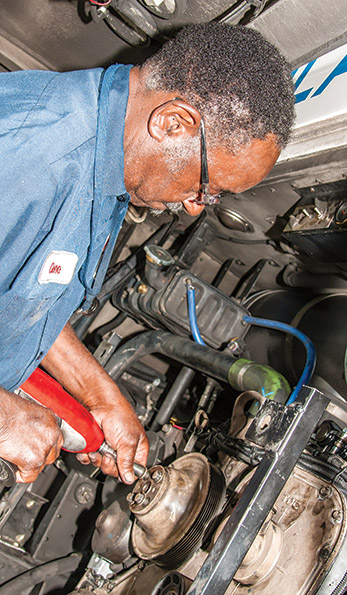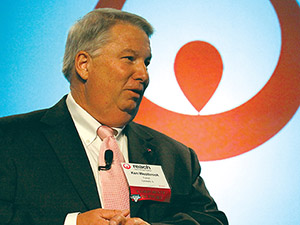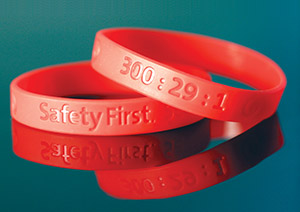
A crafted mix of philosophy, policy and programs guide Veolia Transportation in safety and risk management
By David Hubbard
Risk management is the core component of the typical transit services contract, a subject near and dear to companies such as Veolia Transportation involved in safeguarding the employees and assets of their client agencies and managing risk. According to Ken Westbrook, president and chief operating officer, Transit Division, this is an area where all operators want to be successful.
“It is the contractor’s responsibility to reduce accidents that lead to workman’s compensation and accident claims, and to provide the necessary insurance and risk management,” he says. “This is all part of the overall cost of the service.”
Like most contractors, Veolia is self-insured up to a point. Beyond that, Westbrook says most clients buy insurance to protect against catastrophic loss.
“The client’s RFP will usually spell out how much that insurance should be, as well as the limits on that policy,” he says. “Workman’s comp is usually set by the state but the amount in the RFP generally dictates the major responsibilities. It can run anywhere from $10 million to $25 million depending on the contract. I have seen as low as $1 million, but we certainly don’t recommend anything so low.”
Veolia says it takes safety and risk management very seriously; to the point the safety and risk management departments are working hand in hand.

“Ideally, our goal is to have no claims whatsoever and put the risk management department out of business,” Westbrook says. “But everyone knows that is not reality. We understand we are going to have accidents of one degree or another. Our first priority is to do all we can do to prevent their occurrence. If everyone does their job safely and correctly in a consistent manner, we can greatly reduce the number of accidents that are going to happen, and minimize the damage when they do occur.”
From there, Westbrook says the second priority is to ensure everyone is responsive to the causes of particular types of accidents so something similar does not occur.
For example, a workman’s comp accident in which an employee is injured requires a thorough investigation from both the risk management and safety teams to determine how that accident occurred.
Such investigations might consider such questions as to whether the employee was wearing all the personal protective wear and safety equipment required for the specific job function. Veolia supplies its employees with all safety apparel and gear as part of its safety plan, and expects compliance in these areas.
“Risk management requires a comprehensive understanding of an accident or event,” Westbrook says. “It is never enough to simply accept what has happened and brush it off as ‘just an accident’ without taking pre-established follow-up action. If so, it’s a safe bet it will happen again sooner than later.”
The process involves first educating the employees on all the safety policies and procedures; and then training them continually to work as safe employees. Westbrook says the lessons and training must become engrained in every Veolia employee.
“This must be to the point that with everything they do,” he says. “Every move, every action, each person thinks first, ‘Is this the best way of going about this? Is this safe for me to do? If this becomes their standard behavior on the job, our safety program is a success.”
After that, according to Westbrook, comes risk management, the job of minimizing losses and settling claims as quickly as possible.
“Risk management is also the most difficult,” he says. “We have to get the best settlement for the company and for the injured parties, and unfortunately it requires us to be very aggressive with claims management.”
As is often the case, any small accident that does not involve injury can nonetheless result in people claiming injury.
“If we are vigilant in our risk management, it can mean just opening up the check book,” Westbrook says. “No company can afford to operate that way.”
SmartDrive on board
In this area, Veolia relies on its technology partner SmartDrive, whose onboard cameras and sensors capture triggered events for review as the result of g-force or security actions.
If this happens, safety managers convene with the drivers and employees involved to analyze the incident. Together they determine what happened to trigger the camera and what the employee can do differently in this situation.
“This has been our most effective use of this tool,” Westbrook says. “We don’t use SmartDrive as a ‘gotcha!’ It is about our employees viewing their actions, and arriving at their own solutions for the next time. Our process ultimately makes them better at their jobs.”
He says drivers take pride in seeing the green SmartDrive light at the end of the day, knowing they have completed their shift having done nothing to trigger the camera.
Veolia Drive Program
Veolia has developed its Drive Program as an employee-run initiative that does not involve management — other than to offer guidance and assistance when requested. The employees choose who among them sits on this committee of peers. The Drive committee decides the steps to become better and safer employees.

“Veolia management does not sit in on the Drive meetings, nor do we dictate or even suggest topics for discussion,” Westbrook says. “We may assist with special projects the committee takes up.”
If the work of the committee clearly leads to improvements in safety, lowers the accident rate, or reduces claims, Veolia awards Drive Dollars that the committee can spend to improve the workplace or celebrate a job well done. Westbrook says Drive Rewards have been used for a new television or pool table in the drivers and employees lounge, funded an employee picnic or group tickets to sports events and concerts.
“Drive allows the committee of peers to apply a little pressure to their fellow employees by calling out safety infractions themselves that lead to accidents and claims,” Westbrook says. “The employees then police themselves. The point of this program is employees telling other employees to be safe out there.
Safety and risk management is not just a matter of catastrophic events with horrible, costly or tragic outcomes. The same principles and procedures apply to minor, non-injurious accidents that also cost a company time and money in lost time, down time and inefficiencies.”
Veolia requires a report on every accident.
“What we do not measure, evaluate and report even the slightest damage, we can’t include in the overall safety evaluation,” Westbrook says. “The most inconsequential event can have a horrendous outcome depending on the circumstances. An accident may seem small only because we just got lucky.”
He warns that the next small accident may present a worse scenario. Instead of banging a mirror on light pole, a pedestrian may be stepping off a curb; another vehicle may be in the wrong place at the wrong time.
“It’s all about educating our employees to be aware at every moment,” he says. “Everything we can do to prevent even the slightest accident trains us to work smarter in preventing that one catastrophic event we really do not want.”
Veolia brings its own proprietary risk management and safety plan to each contract. Westbrook says it begins with the company’s proprietary Operator Development Program. This special orientation and training extends to every client, and includes routine audits and Veolia’s own internal OSHA safety inspections, as well as training in claims management.
